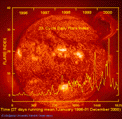
 If
the value of the daily flare index is lower then 10 during the month, the
color of that month is green.
If
the value of the daily flare index is lower then 10 during the month, the
color of that month is green.
 If
the value of the daily flare index exceeds 20 once, then the color of that
month is yellow.
If
the value of the daily flare index exceeds 20 once, then the color of that
month is yellow.
 If
the value of the daily flare index exceeds 40 once, then the color of that
month is red.
If
the value of the daily flare index exceeds 40 once, then the color of that
month is red.
 CLICK
HERE
CLICK
HERE
Solar flares
which are the most energetic explosions in the solar system have a direct effect on the Earth's atmosphere.
A solar flare is defined as an enormous explosion which is observed as
a sudden, rapid, and intense variation in brightness in the solar atmosphere.
It is believed to result from the sudden release of energy stored in the
magnetic fields that thread the solar corona in active regions around sunspots
involving sudden bursts of particle acceleration, pleasma heating, and
bulk mass motion. The Earth's
upper atmosphere becomes more ionized and expands. Long distance
radio signals can be disrupted by the resulting change in the Earth's ionosphere.
A satellite's
orbit around the Earth can be disturbed by the enhanced drag on the satellite
from the expanded atmosphere. Satellite's electronic components can be
damaged. So a flare index is needed to study all the probable solar activities
which affect our satellite environment and
Earth atmosphere. FLARE INDEX is one of the best indicators of activity
variations on the chromosphere. This feature makes the flare index a suitable
full-disk solar index for comparison with similar solar indices which reflect
different physical conditions from the different layers of the solar atmosphere.





